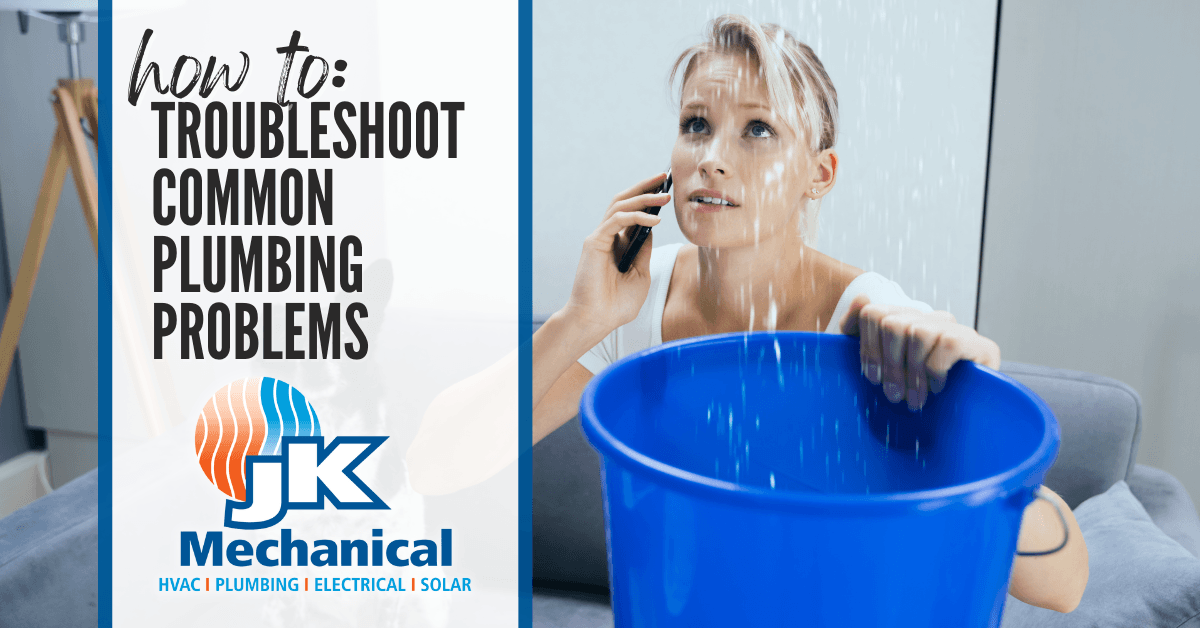How to Troubleshoot Common Plumbing Problems
Part of the benefit of scheduling routine, professional maintenance is the opportunity to identify and solve small problems before they turn into a bigger—and more costly—issue. Over time, however, normal wear and tear on your plumbing system, equipment, and fixtures can lead to breakdowns, leaks, and other issues. Continue reading to learn more about a few of the common plumbing issues JK Plumbers encounter, and how to troubleshoot at home:
Leaky Faucets and Pipes
A leaky pipe, faucet, or water line, or water heater is one of the most common calls we see at JK Mechanical. The first step is to identify, if possible, where the leak is coming from, as this helps identify the specific cause. Depending on the type of fixture that’s leaking, some sources could be:
- The faucet itself (dripping or leaking when not on)
- Around the base of the faucet or fixtures
- At pipes or supply lines, especially at bends/joints or valves
Leaks have a variety of causes, but some examples are wear and tear on the equipment, hard water buildup or sediment causing issues, physical damage (someone running into or bumping the line, which can happen easily in a crowded cupboard or basement), or freezing.
Typically, the next step for serious leaks is to turn the water off at the supply valve as soon as possible, in order to minimize water damage. Then, schedule a plumbing service call so a technician can fix or replace the faulty equipment.
Running Toilet
Does the sound of your toilet tank constantly filling drive you crazy? In addition to the annoying noise, it can also wreak havoc on your water bill.
Like with water leaks, the first step to fixing a running toilet is to identify the source of the problem. The major components of your toilet tank are:
- The fill valve
- The flapper
- The overflow pipe
- The flush lever
Any one of these items may, with time, degrade and stop working as well as it should with a proper fit. Chemical toilet cleaners that go in the tank can also seriously accelerate wear and tear on the tank components, so JK Plumbing Manager Casey Blackwell recommends avoiding them entirely. Take a look inside your tank and look for signs of trouble such as a bad seal on the flapper, a leaky or wild fill valve, or a loose/jiggly flush lever. Some of these issues can be fixed by tightening the flush lever, or installing a new rubber flapper after turning the water off at the supply valve. In other cases, such as an issue with the fill valve or overflow pipe, we recommend speaking with an experienced plumber for guidance.
Low Water Pressure
Is the water pressure in your home not where it should be all of a sudden? If you are on municipal (city) water, a good first step is to check with your neighbors and/or your utility company to see if there is a larger neighborhood issue. If that all checks out (or you’re not on city water at all), low water pressure may be caused by:
- A serious leak somewhere underground or in the system
- A well pump malfunction (private/well water only)
- Or possible a water softener malfunction
These are generally more complicated/involved repairs and can get worse if it is a leak or well pump breakdown, so call JK Plumbing for assistance.
Clogged or Slow-Running Drains
Another common plumbing service issue our team sees are clogged or slow-running drains. Older plumbing lines, especially cast-iron piping, will get buildup over time, especially if you have hard water. Or, clogs are commonly caused by putting material down the drain that really shouldn’t be (food scraps when you don’t have a disposal, grease, kitty litter, kid’s toys, etc).
If the issue is a kitchen drain with a garbage disposal, that may be the cause of the problem and will require a service call to take a look. If it’s a different drain, it’s likely most helpful to have the entire line jetted. For this service, we recommend a specialty line-clearing company such as R&B out of Washington Boro.
Note: If possible, avoid using chemical drain cleaners. Not only are they typically not effective on the root cause, but then if a plumber does need to come out, we now have harsh chemicals in the mix.
Sump Pump Failure
If you have a sump pump in your basement, you might not think about it until something goes wrong. Unfortunately, once a sump pump fails, in most cases a technician will need to come out and install a replacement. You can help prevent unfortunate breakdowns when you need it most by testing your sump pump once a year. Your JK technician will take care of this for you at the time of your JK Plumbing Precision Tune-up. Or, you can do this yourself by manually testing the float or tossing in a bucket of water and watching for it to clear.
Bonus tip: If the issue with your sump pump is not the pump itself but a loss of power during storms or bad weather, consider adding a battery backup sump pump or a whole home standby generator for 24/7, automatic protection that will keep things running, even when the power goes out.
At JK Mechanical, we understand that there’s never a good time for a plumbing breakdown or failure. When it does happen, count on your licensed and trained JK Plumbers for quick, reliable service you can trust.


